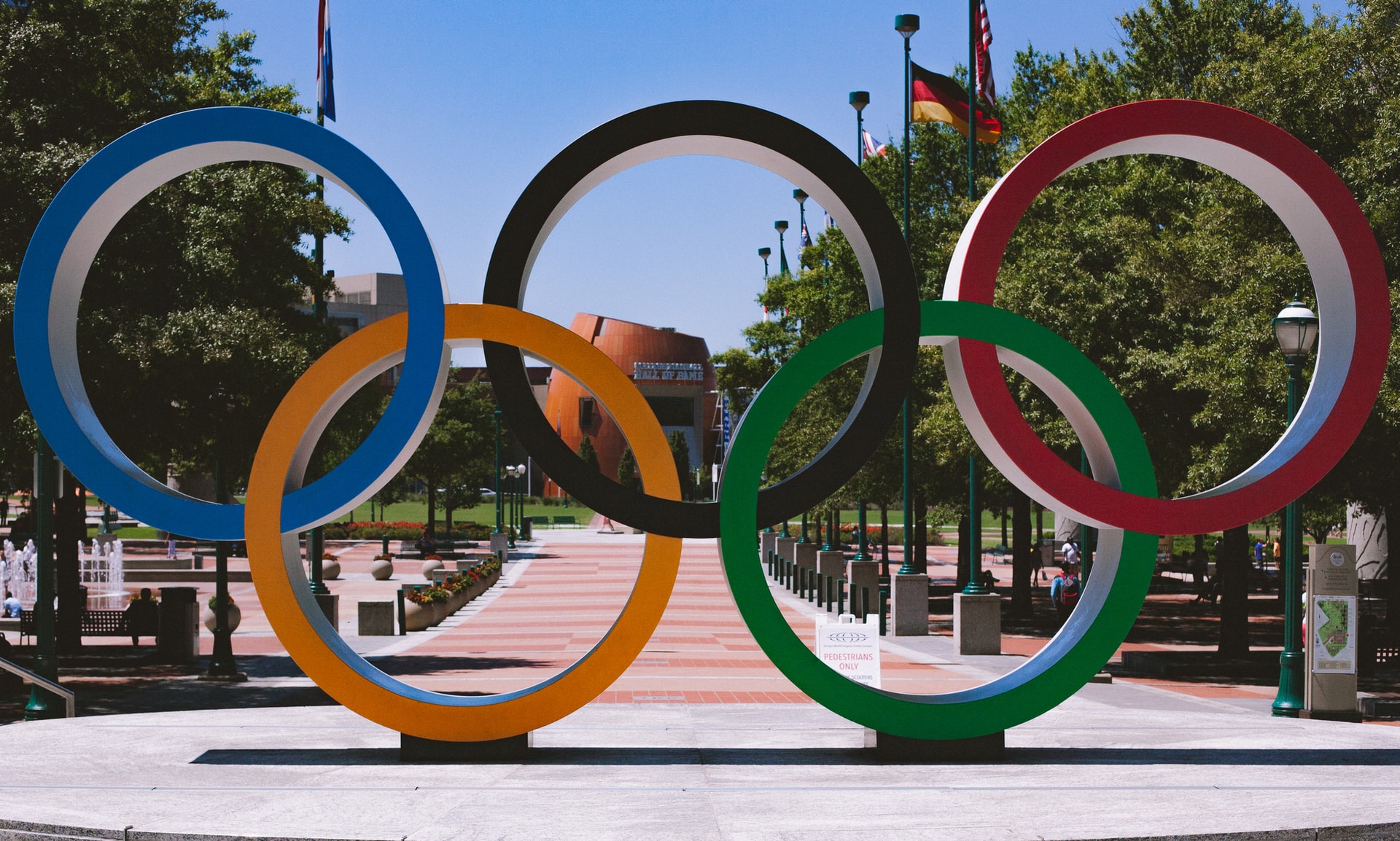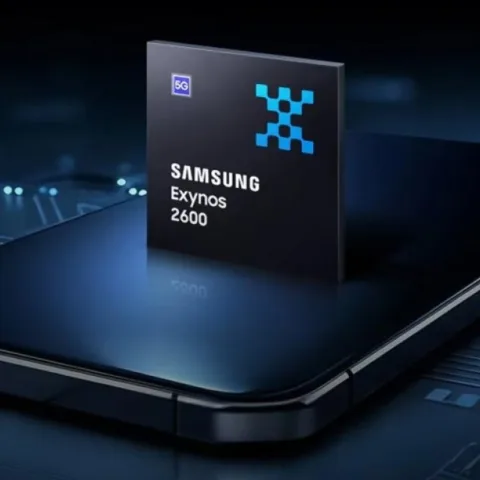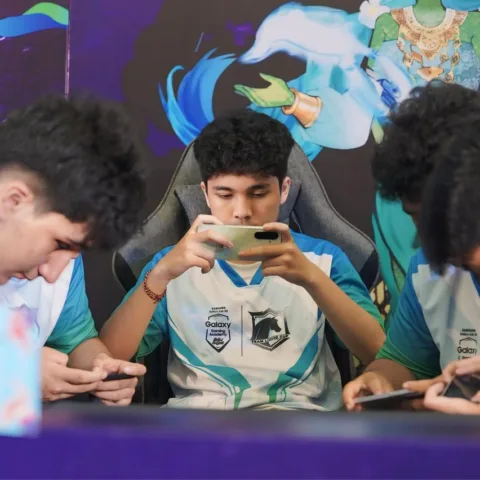In recent years, the popularity of esports has skyrocketed. Even so, there is still a negative stigma attached to the competitive gaming industry. The participation of esports in major sporting events — such as the SEA Games or the Asian Games — can undoubtedly help remove this stigma. Furthermore, the emergence of esports in traditional sports competitions, such as the National Sports Week (PON) or the President’s Cup, can also increase public awareness of esports.
The Olympics is widely regarded as the most prestigious sporting event in the entire world. Previously, Hybrid.co.id had discussed if esports deserves a spot in the Olympics. This time, however, I will compare the process of organizing the Olympics with world-class esports events such as The International and League of Legends Worlds. Through our analysis, we can try to observe if there are any similarities that suggest that esports and the Olympics can be juxtaposed.
Preparation of the Olympics
Even though the Olympics only takes place for 16 days, preparing for the event can take years of effort. The preparation process begins by selecting a hosting country. For instance, the application to host the 2020 Olympics (which will be held in 2021 due to the COVID-19 pandemic) started in May 2011. At that time, the International Olympic Committee (IOC) informed each country’s National Olympic Committees (NOCs) that they could apply to host the 2020 Olympics
In June 2011, the Governor of Tokyo applied as the 2020 Olympic host. Besides Tokyo, several other cities also volunteered, such as Istanbul, Madrid, Baku, Doha, and Rome. However, Tokyo finally took the spot and signed the host contract in September 2013.
As you can see, preparing for the Olympics can take a very long time since the host selection can take 7-12 years before the event starts. In the 2022 Winter Olympics, Beijing was selected as the host in July 2015. Paris, the 2024 Olympics host, got the spot in September 2017. The Olympic Committee intentionally gave this much time due to the tremendous effort required to host the Olympic event successfully.
As a host, the city must not only build an athlete village to accommodate Olympic participants but also build or repair a stadium to run the sporting events. Moreover, the government must also improve the city’s infrastructure, ensuring a warm welcome to the audience, tourists and Olympic personnels that will visit the city.
This year, Tokyo prepared more than 41 thousand hotel rooms for the media, IOC executives, NOC representatives, and representatives of the International Sports Federations (ISF). They also need to take into account the hotels that will accommodate the tourists. Prior to the pandemic, the Tokyo government planned to set up cruise ships in Tokyo ports as temporary hotels. However, the plan was ultimately canceled due to the lack of spectators who watched this year’s Olympics in person.
As for the athletes, Tokyo needs to build an Olympic village, or often called an athletes village. Building this accommodation can be extremely challenging due to the due to the hefty list of conditions that must be met. For example, the location of the village must be close to the stadium or the location of the competition venue. The farthest distance from an athlete’s accommodation to the stadium is set at approximately 50 kilometers and is reachable in 1 hour by car. If there just so happens to be multiple competition venues that are far apart from each other, well the host city must also prepare multiple athlete villages. During the 2014 Winter Olympics, Russia created two separate athlete villages. The primary athlete village was located in Sochi. The second athlete village was in Roza Khutor, built for ski and snowboarding athletes.
Preparation of Esports Events
Now that we have already a basic understanding of the intricacies behind preparing for the Olympics, let’s see what tournament organizers (TO) have to deal with when formulating an esports competition. To be able to fully grasp the process of organizing esports competitions, Hybrid.co.id contacted Herry Wijaya, Head of Operations, Mineski Indonesia, and Irliansyah Wijanarko, Chief Growth Officer, RevivalTV. These two individuals have years of profound experience in organizing esports events.
Besides Herry and Irli, Hybrid.co.id also contacted ESL, one of the most popular tournament organizing brands in esports. ESL frequently held large-scale international esports tournaments around the world. Nick Vanzetti, SVP and Managing Director of ESL Asia Pacific Japan, specifically represented ESL in the interview.
Herry said that to hold a national-level esports competition usually requires 3-6 months of preparation. International tournaments often take double the effort and time, around 6-12 months. According to Irli, preparing large-scale esports events such as The International or LOL Worlds would take around 8-12 months.
“On average, the preparation time is around 8-12 months. The planning and conceptualization phase consumes 3-4 months of work, detailing usually takes 2-3 months long, while promotions will start 2-3 months before the event runs,” said Irli via text message. “Of course, execution and post-event tasks come next.” He added, “World-class esports events often focus on capturing the best moments of the competition and providing an unforgettable experience for the audience. So what’s the job of the tournament organizer? Create as many of these moments as possible.”
“What are these so-called ‘moments’? For the casual audience, they might be interested in creative stage acts/design and entertaining content. On the other hand, the more hardcore fans might seek a suspenseful finals match with a popular or iconic caster. For those with EO experience, they might want to see a smoothly running and coordinated event,” said Irli.
When it comes to holding esports events, Irli explained that four stakeholders or groups must be considered. These are the players/talents, audiences, sponsors, and developers or IP owners. The crew that runs behind the curtains must also be taken into account. Depending on the scale of the competition, additional stakeholders, such as the government or competing companies, might also be involved.
“Tournament organizers must carefully analyze each of these potential stakeholders and how they might find the event memorable (in a positive sense). Different stakeholders, of course, have different needs and priorities. For the crew, they might want good food and hotel accommodation. Talents might require an organized script to simplify things on stage. The audience will undoubtedly want a high-quality production with proper visuals and sound mixing. Sponsors need to make sure that their KPI targets are met. So on and so forth.”
According to Herry, here are the most important elements to prepare and plan when organizing a tournament:
- Venues and mandatories
- Hard production and soft production
- Property
- Production equipment
- Hospitality
- Talents
- Internet and communication
- Other miscellaneous items, such as stationaries or hard disks
“Mandatories are essentially everything that will be required when using a venue,” said Herry. “For example, if we want to use Tennis Indoor Stadium in Senayan, we have to assemble a fire department and prepare an ambulance, according to their standard procedures. Furthermore, we also have to prepare a crowd permit.” He also added that there are two types of production equipment. Hard production involves stages, booths, gates, and everything physical or tangible. On the other hand, Soft production deals with tools required to create digital content, such as digital assets. Hospitality encompasses hotels, food, and transportation arrangements.

Esports competitions are frequently sponsored by endemic brands, such as smartphone companies for mobile esports competitions or hardware manufacturers for PC esports tournaments. Sponsors can opt to give away their products to resell, while sometimes they can also lend them. It all depends on the signed contract.
“Sponsors often supply their products or services instead of finances to support the event. We call them In-kind sponsors. Sometimes, the sponsors can allow us to resell the items they provide,” said Herry. “Other times, it is only a matter of a lease, and we would have to return the sponsor’s product after the event has concluded. It is incredibly important to understand the product’s presence to make sure that we do not get into any illegal circumstances.”
In line with Herry and Irli, Nick revealed that ESL takes about a year to organize a world-class esports event. He also added that workloads significantly increase when the D day of the event gets closer.
“There is a lot of preparation to be made to hold an international event,” said Vanzetti. “First, we have to find a venue that fits our criteria and needs regarding the size of the event.” He revealed that capacity, internet availability, location, and reachability are some of the factors that ESL considers when selecting a venue.
“We will also ensure that players, talents, ESL employees, and all parties that will be attending and running the tournament are set up with the appropriate accommodations and travel needs such as visas, flight tickets, hotels, and so on,” said Vanzetti. He emphasized that ESL highly prioritizes ensuring that all parties involved in organizing esports competitions have a satisfying experience, starting from when they depart, running the event, and until they return to their respective homes.
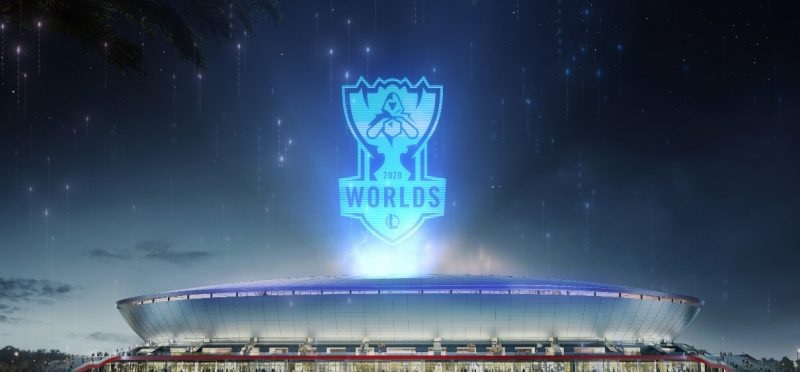
How does a tournament organizer determine the city that will host the international esports competition? According to Herry, TOs usually adjust to the client’s goals and expectations. If the client’s goal is to reach out to their fans, then Mineski will select a city with a highly enthusiastic community in the game. On the flipside, Mineski will recommend a new city that has little to no fanbase if the client wishes to expand their gaming market to new consumers.
Vanzetti also mentioned that the size of the market or community surrounding the city is one of ESL’s primary benchmarks when determining a host location. However, another factor that ESL often takes into consideration is the local government’s interest in esports.
“The hosting city can frequently provide support to the tournament or event through various methods. For instance, they can help us get visas for the players and staff. They can also assist the marketing department or aid the venue rental or accommodation costs,” said Vanzetti. “Through the bidding system, TOs will be able to select cities that offer strategic advantages and benefits so that they can successfully organize a world-class esports event.”
However, according to Irli, the only publisher that currently uses a bidding system in choosing a city to hold an esports competition is Valve. He explained that Valve gave event organizers the opportunity to submit proposals for holding a Major tournament. It is the organizers themselves who will propose the city to be the tournament host.
“From my experience, the factors that need to be considered when organizing national and international scale events are the facilities in the city, the number of players in and around the city, accessibility to the city, such as airports, hotels, distance to the venue,” said Iril. “Product support from sponsors in the city, political conditions, and enthusiasm from local communities are also quite important.”
Tournament organizers must also be able to manage manpower or human resources (HR). According to Herry, 40 to 60 personnel are usually required to hold an online competition. This figure can expand to 80-120 people if the tournament is held offline. Moreover, to hold an international offline competition, Herry estimates that only a minimum of 150-170 people will suffice. However, not all the organizer crew is composed of Mineski’s personnel. More often than not, some are part of the “familia”, freelancers who continue to work for Mineski.
On ESL, the manpower size is even larger, usually involving more than 200 staff and contract workers according to Vanzetti. “In addition to hiring ESL staff, we often collaborate with local suppliers and companies to help us organize events,” he said. In Irli’s estimation, an organizing team holding world-class esports events like The International or LOL Worlds can approximately accumulate 200-300 staff in all positions. The number of required staff is usually correlated with the venue size and location as well.
“The bigger the event and venue, the larger the staff size needed to run the whole show, up to 500-600 people,” he said. “Fortunately, the costs of labor can often be reduced through volunteers or freelancers who are paid hourly or per day.” He used the Djakarta Warehouse Project (DWP), arguably Indonesia’s largest music, as a comparison. He said that DWP’s organizing crew can consist of a total of 1000 personnel. However, the core team usually consists of only 50-100 people. The rest of the crew is filled with volunteers and freelancers who look to support the event.
Olympic Viewership Trends and Esports Competitions
Viewership can be a barometer of the success of a particular event. Unfortunately, when it comes to comparing the successes of the Olympics and esports tournaments, viewership can be a tricky metric to handle. The reason is simple: these two events are broadcasted in different media.
Unlike TV, there is no such thing as ratings in streaming broadcasts. Instead, the average or peak number of viewers and watch hours are more relevant statistics when it comes to streaming. Therefore, in order to compare the Olympic viewership with TI and LOL Worlds, we need to consider the viewership statistics in each of the events and observe any general trends (upwards or downwards) that might be present.
In the United States, the Olympics are usually broadcast by NBC (National Broadcasting Company). According to data from Nielsen, 16.9 million people watch the Tokyo Olympics opening ceremony. If we compare this figure with the viewer numbers in previous years, 2021 holds the unwanted record of the smallest number of viewers. Furthermore, Tokyo Olympics viewership numbers were half of Rio de Janeiro’s Olympics spectator numbers in 2016. NBC, unfortunately, might regret their $7.65 billion USD Olympics broadcast rights contract extension that lasts until 2032 after facing this downward trend.
Here’s the Tokyo Olympics viewership numbers compared to the five-day Rio Olympics:
Tuesday, 27 July 2021, viewership dropped by 58%
Wednesday, July 28, 2021, viewership dropped by 53%
Thursday, July 29, 2021, viewership dropped by 43%
Saturday, July 31, 2021, viewership dropped by 57%
Sunday, August 1, 2021, viewership dropped by 51%
As you can see from the data above, the drop in viewers in the Tokyo Olympics is catastrophic. According to an AP News report, the peak viewership of the Tokyo Olympics broadcasted on NBC occurred on Thursday, July 29, 2021, which was 16.2 viewers. Even so, this figure is still 43% lower than that of the Rio Olympics 4 years ago.
NBC Universal CEO Jeff Shell hypothesized several factors that caused the plunge in this year’s Olympic broadcast. One of the most obvious factor is the pandemic, which ultimately postponed the Olympics by a whole year. The pandemic also prohibited live spectators who want to watch the event in person. Another factor is the adjustment of broadcast hours. The time difference between Tokyo and Washington DC is a whopping 13 hours. To combat this problem, NBC and other media companies offer broadcasts from more platforms and more schedules. However, according to Reuters, this actually confuses the viewers and hinders them from finding the content they want to watch.
Now, let’s move on to the viewership of The International and LOL Worlds.
I will use the most common metrics or measure of viewership, namely hours watched, the average number of viewers, and the peak number of viewers. For my source of data, I referred to Esports Charts. As a side note, The International 2020 had to be postponed due to the COVID-19 pandemic. Therefore, the statistics for this year’s International will be intentionally left out as 0.
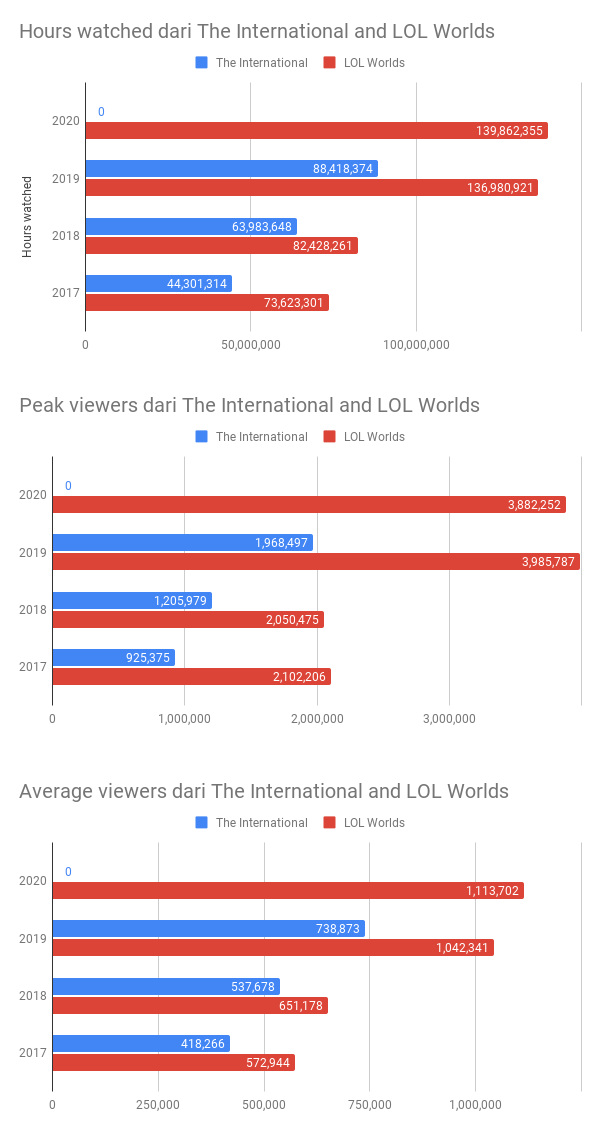
As you can see in the chart above, The International’s viewership continues to show an upward trend across all metrics in the past few years. The viewership number of LOL Worlds also seems to follow the same exact trend. During 2019 in particular, the average number of viewers even experienced rapid growth, almost 60% greater than the last year. However, in terms of peak viewers and hours watched, LOL Worlds’ figures occasionally stagnate or decline marginally.
You can also see the viewership for LOL Worlds 2020 and The International 2019 in the diagrams below.


Of course, the Olympics’ viewership numbers are far more superior to any esports events in history. However, esports has one other advantage over the Olympics: a younger demographic of viewers. As of 2016, the average age of an Olympic spectator was 53 years old. On the other hand, the average age of an esports audience is 26 years old. If you want to understand what this data suggests, you can take a look at this article here.
Profitability
Besides viewership, another metric that can be used to measure the success of a particular event is its ability to yield financial gain, or profitability for short. So let’s take a deeper look at the detailed costs involved in running the Olympics and esports events as well as the advantages/disadvantages of the host city.
The financial resources prepared by different host cities to hold the Olympics vary. However, one thing is for sure, the funds allocated can reach billions or even tens of billions of dollars. For instance, the 2018 Winter Olympics in Pyeongchang is estimated to cost $12.9 billion USD, and the 2010 Winter Olympics in Vancouver cost $6.4 billion USD. Similarly, to host the 2012 Olympics and Paralympics, London allocated a budget of around $14.6 billion USD. To hold the 2008 Olympics, Beijing reportedly spent $42 billion USD.
Of course, these funds are not only spent on sports infrastructure, such as stadiums. As Investopedia noted, cities designated to host the Olympics will usually also work on developing other basic infrastructures by building new roads, or renovating airports, or building new hotels to accommodate the population surge during the Olympics.
During the 2016 Olympics, Rio reportedly built 15 thousand new hotel rooms to accommodate the potential tourists. Sochi spent $42.5 billion USD to build non-sporting infrastructure for the 2014 Olympics. Of the tens of billions of dollars Beijing spent on the 2008 Olympics, $22.5 billion USD was spent on renovating roads, airports, subways, and trains. They also spent $11.25 billion USD to clean up the city environment.
The improvement of infrastructure that the host government requires will, in turn, open up thousands of new job vacancies in the city. This is one of the advantages of taking up the opportunity in hosting the Olympics. Morever, the flock of sponsors, media, athletes, and spectators that visit the city will generate a lot of revenue for the local government.
Apart from tourists, the Olympics also have several other sources of income. One of them is the sale of licenses. Unfortunately, since the 2008 Olympics, Olympic license prices have continued to fall. You can see this in the graph below, obtained from Statista.

Marketing is another source of income for the Olympics. Unlike license prices, the Olympic income from marketing shows an upward trend for the past few years. Between 2013-2016, revenue from marketing did experience a minor decline from $8 billion USD in 2009-2012 to $7.8 billion USD in 2013-2016. But of course, this 3% drop is not very large by any standards.
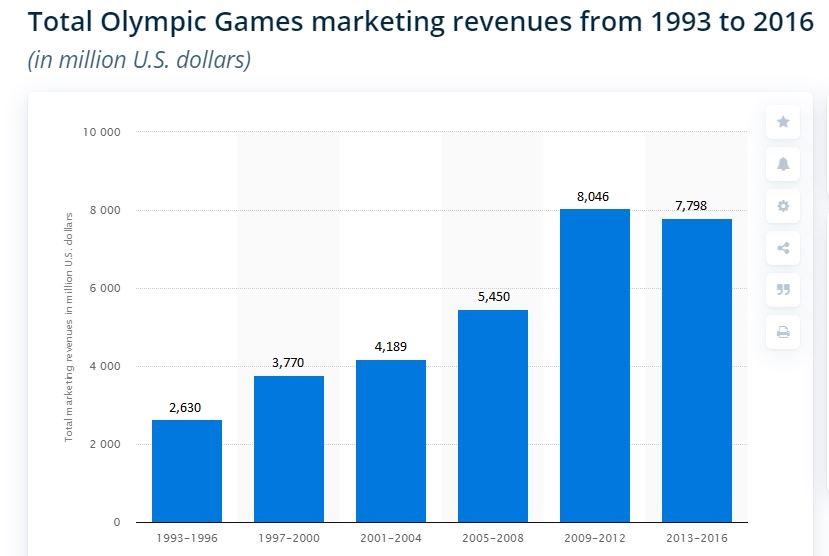
Unfortunately, hosting the Olympics also poses its own problems. Despite the enormous costs incurred to organize the Olympics, host cities frequently find diminishing returns from the event. To hold the 2010 Winter Olympics, Vancouver spent a colossal $7.6 billion USD but only managed to rack up a profit of $2.8 billion USD.
Sometimes, the Olympics don’t even provide that many new job opportunities in the city. For example, Salt Lake City (the host of the 2002 Olympics) reportedly only found 7 thousand new job openings, 10 times smaller than its initial estimations. Even worse, most of the job availability is usually aimed at individuals with existing jobs. Therefore, the argument that the Olympics can potentially solve the problems of unemployment is simply inaccurate.
More often than not, a large proportion of business opportunities that result from hosting the Olympics also benefit international companies instead of local enterprises. However, the biggest issue of hosting the Olympics is the abandonment of the infrastructure built for the event. When the Olympics come to a close, athletes villages and sports stadiums essentially serve no more purpose and are often left out to rot.

Now that we have a clear picture of the requisites and budget of organizing the Olympics, let’s compare the required costs of holding esports events ranging from the national level to world-class tournaments such as TI or LOL Words
In terms of expenses, Vanzetti estimated that organizing world-class esports events would need a budget in the range of millions of dollars. Likewise, Herry estimates that the national-level esports tournament will cost around $500 thousand USD to US$1 million USD, while international-level tournaments would usually double that figure. He also predicts that holding The International or LOL Worlds would require a budget of $5-10 million USD. Irli also had a similar opinion with Herry, expecting that organizing TI or LOL Worlds will most likely have a minimum cost of $5 million USD.
“In terms of budget details, 50% is allocated to production, 20% to hospitality and manpower, 20% to promotions, and 10% for other miscellaneous works,” said Irli. “That’s usually the rough proportions, but it mostly depends on the client’s goals and needs. Some clients may want to focus more on increasing the production value, which means that more resources will be designated to production. Valve, for example, is always interested in creating stories and movie content based on the competition. I personally like to put more effort into producing lavish opening ceremonies, using state-of-the-art broadcasting technology, and so on.”
The content that Valve produces to support The International is True Sight. True Sight is a documentary series that showcases behind-the-scenes footage, stories, and experience of the Dota 2 pro players during TI or Majors. Unlike Valve, Riot Games prefers to present a grand opening ceremony. At LOL Worlds 2017, Riot flew a virtual dragon at the Beijing National Stadium. In 2018, Riot’s virtual K-Pop group, KDA, performed in front of the LOL World’s stage using augmented reality technology. Riot upped the performance yet again in 2019 by using cutting-edge holographic technology, which made the KDA members look highly realistic.
So, are esports tournaments profitable?
In 2018, Derrick Asiedu, Head of Global Events in Riot Games, revealed that Riot spends more than US$100 million per year on its esports program but is still miles away from making a return in capital. Fortunately, Riot’s effort in expanding its esports has allowed League of Legends’ esports ecosystem to thrive and attract millions of audience. Even though Riot might not have made a profit from esports for the moment, it successfully kept LOL relevant for more than 10 years. Consequently, Riot still can generate income through in-game content or sales to balance out their financial losses in esports.
When compared to traditional sports competitions like the Olympics, esports also have a different model of monetization. 40% of traditional sporting events’ income usually come from sponsorships, 40% from broadcasting, and 20% from ticket and merchandise sales. As for esports, 80% of revenue comes from sponsorships, 15% from broadcasting, and 5% from ticket and merchandise sales, according to Alban Dechelotte, Head of Business Development and Sponsorship, League of Legends European Championship (LEC).
“We could go on only one platform and be exclusive,” Dechelotte told GamesIndustry, “We may have more revenue but we lose viewership which is important because at the end of the day, it’s a marketing tool for the game. So sponsorship becomes the number one priority for us, because compared to traditional sport, it’s double the weight in terms of revenue.”
In line with Asideu, Irli also estimated that sponsorships contribute to 80% of esports events’ income, and the rest of the 20% comes from ticket sales, merchandise, and so on. “These proportions are perhaps why most esports events today are held by the game developer/publisher themselves,” he said. “Esports sadly hasn’t been able to create revenue streams from ticket sales alone. It still primarily functions as a marketing tool for publishers with the sole purpose to create exposure for the game. Events such as The International and LOL Worlds can push revenue contributions of merchandise and ticket sales to around 30%-40%, but the rest still lies on the sponsors.”
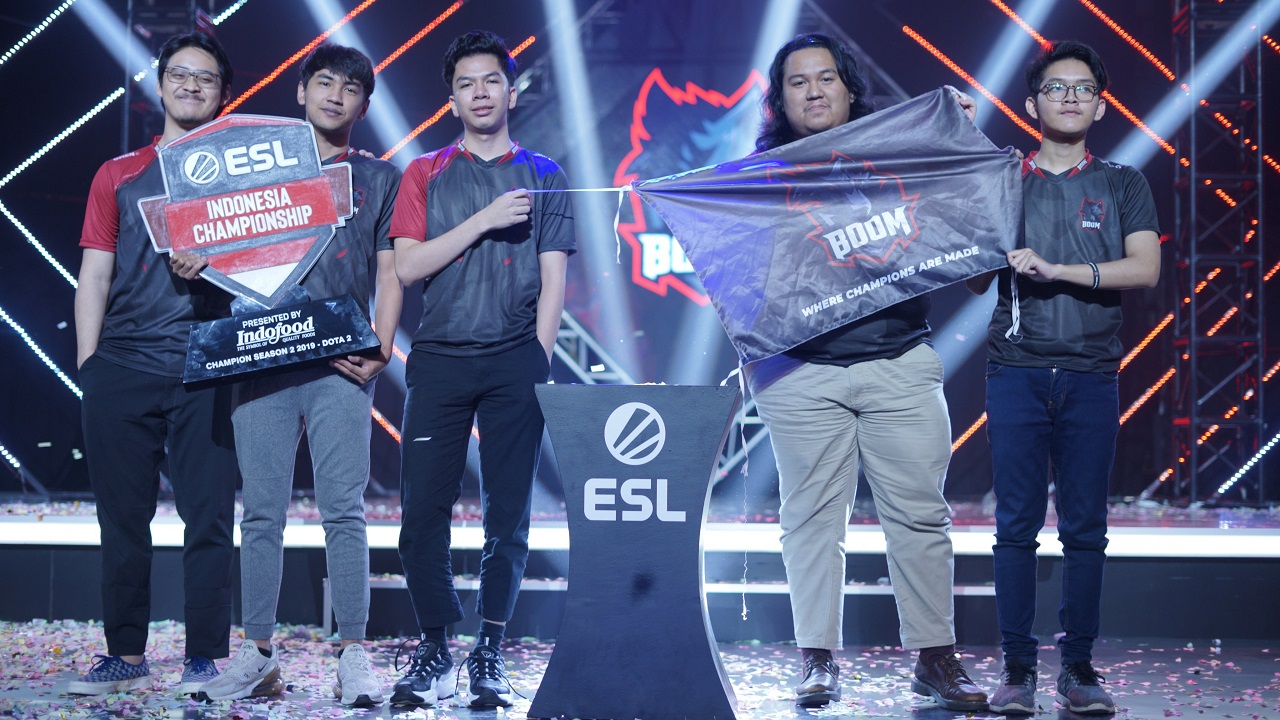
Moreover, holding international esports tournaments can highly benefit local companies in the host city. Vanzetti mentioned that ESL does have its own private equipment and personnel to maintain the integrity of its events. However, ESL also frequently works with local suppliers for stage procurement, such as sounds, lights, and LEDs.
“For some parts of the event, we usually get help from local companies, such as for the procurement of furniture, security barriers, and cameras,” said Vanzetti. “Local companies can have the opportunity to earn big profits through hosting world-class esports competitions in their city or country.”
Conclusion
Preparation for holding the Olympics is much more complicated and takes much longer than holding esports events, even for prestigious tournaments like The International or LOL Worlds. Furthermore, in terms of cost, organizing the Olympics requires a much larger budget, up to billions of dollars, compared to the million-dollar range of esports tournaments. Even so, the Olympics never fails to attract millions of television viewers around the globe. Unfortunately, the number of Olympic spectators has experienced a continuous decline for the past few years, perhaps due to the changes in modern viewing habits. More people today, especially the younger generation, simply prefer watching online streams instead of TV.
In terms of income, both the Olympics and esports events can sometimes prove to be unprofitable. However, esports has always been used primarily as a marketing tool, not as an additional income stream. Game developers’ source of revenue still stems from selling games or in-game items. As for its purpose, esports has been incredibly effective in maintaining the longevity of many franchises such as League of Legends, Dota, or Counter-Strike: Global Offensive. Rainbow Six has also benefited from its esports ecosystem, as seen by its growing number of players for the past few years.
Featured Image: Unsplash. Translated by: Ananto Joyoadikusumo.

